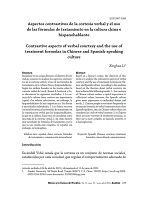Contrastive aspects of verbal courtesy and the use of treatment formulas in Chinese and Spanish-speaking culture
DOI:
https://doi.org/10.32870/mycp.v11i31.763Keywords:
Spanish, Chinese, courtesy, treatment formulas, intercultural communicationAbstract
Based on a literary corpus, the objective of this work is to analyze the contrastive aspects of verbal courtesy and the use of treatment formulas in Chi-nese and Spanish culture. According to the analyzes based on the theories about verbal courtesy, we have achieved the following results: 1. The courtesy of Chinese culture confers a capital importance to collectivist values, however, the Spanish culture gives more importance to individual desires and needs; 2. Chinese people resort more frequently to treatment formulas in verbal communication than Spanish speakers, since in Chinese culture these are considered as a rule of verbal courtesy; 3. In Chinese there are more varieties of treatment formulas, so their use is more complex, in Spanish, however, it is homogeneous.Downloads
References
Álvarez, A. I. (2005). Hablar en español. Ediciones Nobel.
Briz, G. E. A. (2010, agosto 23-25). La cortesía al hablar español [Presentación
de trabajo]. III Jornadas de formación de profesores de E/LE, Beijing, China. http://www.sinoele.org/images/Revista/3/iiijornadasP_Briz.pdf
Brown, P., & Levinson, S. (1987). Politeness. Some universals in language usage.
Cambridge University Press.
Cao, Y. (2013). ?? [La Tempestad]. ??????? [People’s Literature Publishing House].
Castellano, M. D. (2012). Cortesía verbal y fórmulas de tratamiento nominales en el habla de Medellín. Lingüística y literatura, 33(62), 123-139. https://revistas.udea.edu.co/index.php/lyl/article/view/14528
Cela, C. J. (2001). La colmena. Cátedra.
Dueñas, M. (2010). El tiempo entre costuras. Temas de hoy.
Escandell, M. V. (1993). Introducción a la pragmática. Ariel Lingüística.
Gu, Y. (1990). Politeness phenomena in modern Chinese. Journal of Pragmatics, 14(2), 237-257. https://doi.org/10.1016/0378-2166(90)90082-O
Gu, Y. (1992). Li mao yu yong yu wen hua [Cortesía, pragmática y cultura].
Foreign Language Teaching and Research, (4), 10-17.
Hu, H. C. (1944). The Chinese concepts of ‘face’. American Anthropologist,
(1), 45-64. https://doi.org/10.1525/aa.1944.46.1.02a00040
Jin, X., & Chen H. (2016). ?? [Libro de los ritos]. ???????[Shanghai
Classics Publishing House].
Lao She. (2003). ?? [La casa de té]. ??????? [People’s Literature Publis-
hing].
Lao She. (2010). ???? [El camello Xiangzi]. ?????[Nanhai Publishing
House].
Leech, G. N. (1983). Principles of pragmatics. Longman.
Lee-Wong (1998). “Face support-Chinese particles as mitigators: A study of
BA A/YA and NE”. Pragmatics, 8, 387-404.
Mao, L. R. (1994). Beyond politeness theory: ‘Face’ revisited and renewed.
Journal of Pragmatics, 21(5), 451-486. https://doi.org/10.1016/03782166(94)90025-6
Martínez-Cabeza Lombardo, M. A. (1997). La cortesía verbal: perspectiva pragmalingüística. En J. A. de Molina Redondo, J. de Dios Luque Durán & F. Fernández (Coords.), Estudios de lingüística general: conferencias y trabajos presentados en el II Congreso Nacional de Lingüística General (Vol. 2, pp. 231-244). Método Ediciones.
Matsumoto, Y. (1988). Reexamination of the universality of face: Politeness
phenomena in Japanese. Journal of Pragmatics, 12(4), 403-426. https://doi.org/10.1016/0378-2166(88)90003-3
Matsumoto, Y. (1989). Politeness and conversational universals – observations from Japanese. Multilingua – Journal of Cross-Cultural and Interlanguage Communication, 8(2-3), 207-221.
Mo, Y. (2012a). ?????? [Las baladas del ajo]. ????? [Writers Publishing House].
Mo, Y. (2012b). ???? [Grandes pechos, amplias caderas]. ?????[Writers
Publishing House].
Pérez-Galdós, B. (1992). Fortunata y Jacinta: dos historias de casadas. Cátedra.
Qian, Z. (2013). ?? [La fortaleza asediada]. ??????? [People’s Literature
Publishing House].
Qu, W., & Chen, S. (1999). Explicación de las fórmulas de tratamiento corteses.
Journal of East China Normal University, 6, 118-124.
Sánchez-Ferlosio, R. (2006). El Jarama. Espasa.
Sifianou, M. (1992). Politeness phenomena in England and Greece: A Cross-
Cultural Perspective. Oxford University Press.
Yu, H. (2010). ?? [¡Vivir!]. ??????? [People’s Literature Publishing House].

Downloads
Published
Versions
- 2022-01-24 (3)
- 2021-12-14 (2)
- 2021-12-14 (1)
How to Cite
Issue
Section
License
Copyright (c) 2021 México y la Cuenca del Pacífico

This work is licensed under a Creative Commons Attribution-NonCommercial-ShareAlike 4.0 International License.
Open Access Policy
This journal provides open access to all its contents, in adherence to the principle that making research freely available supports a greater global exchange of knowledge.
MyCP is licensed under a Creative Commons Attribution-NonCommercial license, also known as CC BY-NC.
Contents are published in both PDF and XML formats.
Authors who publish in México y la Cuenca del Pacífico must accept the following conditions:
Pursuant to Mexican copyright laws, México y la Cuenca del Pacífico acknowledges and respects the authors’ moral right and ownership of property rights, which will be assigned to the University of Guadalajara to publish the articles in an open-access mode.
México y la Cuenca del Pacífico does not charge the authors any fees for receiving and processing their articles.
Authors are permitted to enter into other independent and additional contractual agreements for the non-exclusive distribution of the article version published in México y la Cuenca del Pacífico (for example, publishing it in an institutional repository or in other printed or electronic media) as long as they clearly state that the piece was originally published in México y la Cuenca del Pacífico.
Pursuant to the above, once the article is approved for publication, authors must send the Assignment of Rights Agreement form duly filled and signed. This form must be sent to mexicoylacuenca@gmail.com as a PDF file.
Readers/users of México y la Cuenca del Pacífico can freely access the journal new issues as soon as they are uploaded. Readers/users are allowed to cite, share (both electronically and physically), print and distribute the material, provided they expressly state that the work was originally published in México y la Cuenca del Pacífico. Contents are to be properly cited and never for commercial purposes.




